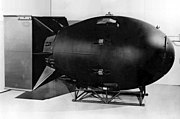
The first nuclear weapons were gravity bombs, such as the "Fat Man" weapon dropped on Nagasaki, Japan. These weapons were very large and could only be delivered by a bomber aircraft
Nuclear weapons delivery—the technology and systems used to bring a nuclear weapon to its target—is an important aspect of nuclear weapons relating both to nuclear weapon design and nuclear strategy. Additionally, developing and maintaining delivery options is among the most resource-intensive aspects of nuclear weapons: according to one estimate, deployment of nuclear weapons accounted for 57% of the total financial resources spent by the United States in relation to nuclear weapons since 1940.[6]
Historically the first method of delivery, and the method used in the two nuclear weapons actually used in warfare, is as a gravity bomb, dropped from bomber aircraft. This method is usually the first developed by countries as it does not place many restrictions on the size of the weapon, and weapon miniaturization is something which requires considerable weapons design knowledge. It does, however, limit the range of attack, the response time to an impending attack, and the number of weapons which can be fielded at any given time. Additionally, specialized delivery systems are usually not necessary; especially with the advent of miniaturization, nuclear bombs can be delivered by both strategic bombers and tactical fighter-bombers, allowing an air force to use its current fleet with little or no modification. This method may still be considered the primary means of nuclear weapons delivery; the majority of U.S. nuclear warheads, for example, are represented in free-fall gravity bombs, namely the B61.[2]
More preferable from a strategic point of view are nuclear weapons mounted onto a missile, which can use a ballistic trajectory to deliver a warhead over the horizon. While even short range missiles allow for a faster and less vulnerable attack, the development of intercontinental ballistic missiles (ICBMs) and submarine-launched ballistic missiles (SLBMs) has allowed some nations to plausibly deliver missiles anywhere on the globe with a high likelihood of success. More advanced systems, such as multiple independently targetable reentry vehicles (MIRVs) allow multiple warheads to be launched at several targets from any one missile, reducing the chance of any successful missile defense. Today, missiles are most common among systems designed for delivery of nuclear weapons. Making a warhead small enough to fit onto a missile, though, can be a difficult task.[2]
Tactical weapons (see above) have involved the most variety of delivery types, including not only gravity bombs and missiles but also artillery shells, land mines, and nuclear depth charges and torpedoes for anti-submarine warfare. An atomic mortar was also tested at one time by the United States. Small, two-man portable tactical weapons (somewhat misleadingly referred to as suitcase bombs), such as the Special Atomic Demolition Munition, have been developed, although the difficulty to combine sufficient yield with portability limits their military utility.[2]

